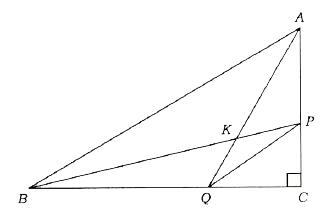If ABC is a right-angled triangle with AC as its hypotenuse, then which one of the following is correct ?
AC3<AB3+BC3
AC3>AB3+BC3
AC3≤AB3+BC3
AC3≥AB3+BC3
To solve the problem, we need to analyze the properties of a right-angled triangle, particularly focusing on the relationship between the sides according to the Pythagorean theorem.
1. Identify the Right-Angled Triangle:
We have a triangle ABC where angle B is the right angle. Thus, AC is the hypotenuse.
2. Recall the Pythagorean Theorem:
The Pythagorean theorem states that in a right-angled triangle, the square of the length of the hypotenuse (AC) is equal to the sum of the squares of the lengths of the other two sides (AB and BC). This can be expressed as:
AC2=AB2+BC2
3. Analyze the Options:
We need to determine which of the given options is correct based on the Pythagorean theorem. The options provided are:
- (i) AC3<AB3+BC3
- (ii) AC3>AB3+BC3
- (iii) AC3≤AB3+BC3
- (iv) AC2=AB2+BC2
4. Select the Correct Option:
From the Pythagorean theorem, we know that AC2=AB2+BC2 is true. Therefore, option (iv) is correct.
5. Conclusion:
The correct answer is:
AC2=AB2+BC2
We have a triangle ABC where angle B is the right angle. Thus, AC is the hypotenuse.
The Pythagorean theorem states that in a right-angled triangle, the square of the length of the hypotenuse (AC) is equal to the sum of the squares of the lengths of the other two sides (AB and BC). This can be expressed as:
AC2=AB2+BC2
We need to determine which of the given options is correct based on the Pythagorean theorem. The options provided are:
- (i) AC3<AB3+BC3
- (ii) AC3>AB3+BC3
- (iii) AC3≤AB3+BC3
- (iv) AC2=AB2+BC2
From the Pythagorean theorem, we know that AC2=AB2+BC2 is true. Therefore, option (iv) is correct.
The correct answer is:
AC2=AB2+BC2
Similar Questions
Knowledge Check
In a triangle ABC if the angles A, B, C are in AP, then which one of the following is correct ?
Ac = a + bBc2=a2+b2−abCa2=b2+c2−bcDb2=a2+c2−acLet A(1,k), B(1,1) and C(2,1) be the vertices of a right angled triangle with AC as its hypotenuse. If the area of the triangle is 1, then the set of values which 'k' can take is given by
A(1,3)B(0,2)C(-1,3)D(-3,-2)Let A(1,k),B(1,1) and C(2,1) be the vertices of a right angled triangle with AC as its hypotenuse. If the area of the triangle is 1, then the set of values which k can take is given by:
A(1,3)B(0,2)C(-1,3)D(-3,-2)
The maximum area of a right angled triangle with hypotenuse h is
View SolutionIn a right angle triangle ΔABC a point D is situated on side BC where AB is hypotenuse of triangle. Then, which of the following is correct-
View SolutionThe median BD of the triangle ABC meets AC at D. If BD=12AC , then which one of the following is correct ?
View SolutionLet A(1,k),B(1,1) and C(2,1) be the vertices of a right angled triangle with AC as its hypotenuse. If the area of the triangle is 1, then the set of values which k can take is given by:
View SolutionIn a right angled triangle ABC, CD is the perpendicular on the hypotenuse AB. Which of the following is correct?

View Solution

